Though the deep logs of watch information and seemingly endless internet rabbit holes make it seem otherwise, there was a time - and not all that long ago - where the luxury of quickly and easily searching for watch information was not yet a reality. Brand publications, catalogs, archives, and the records of authorized dealers were the gold standards when it came to identifying owner-unknown details about a watch.
As the internet started to see some sites and forums in the watch space (mid/late 1990s), collectors started to pool, and document, the knowledge that had been accumulating outside of official brand and industry mediums for decades. Incredibly useful information such as reference numbers, dial configurations and variations, movement developments and innovations, and arguably above all, details to differentiate the authentic from the inauthentic found a living, breathing home on the internet.
The present-day person searching for some bit of information about their watch can stumble upon their answer within minutes, if not seconds, just by typing in a few words or a serial number into their search engine of preference. Major and micro watch brands, too, moved many of their archived information to websites and online databases, making it possible to pinpoint exactly when most watches would have been produced. It’s a modern-day marvel of data collection, historical journalism, and information accrual.
Why, you may ask, is this the introduction to today’s piece of writing?
Well, I’ll show you:
This is the Bulova Oceanographer, and it exists entirely uncatalogued with the exception of a few for sale lots. When I saw this watch for the first time, I immediately thought of it as a smaller, less daunting Rolex Submariner. Similar to the Subs of the ‘80s and ‘90s, the Oceanographer really doesn’t hide its inspiration much, with even the name taking a cue from the nautical life.
Easy, right? A quick Submariner homage search and we’ll be on our way to finding out more about this piece, case closed!
…nope. Nopety-nope-nope.
The Oceanographer line from Bulova is one with a rich history of both design and application, especially when it comes to the famed Devil Diver (name attributed to its water resistance of 666 feet), and there are many modern and vintage iterations of these references. Only trouble is that this particular Oceanographer - that of the Submariner influence - is nowhere to be found in Bulova’s archives, vintage advertisements, reference or serial number lists…you get the idea.
I was able to find a handful of both active and closed lots of this watch for sale, and let’s just say the information provided was…varied. Some sellers of this watch claimed it was from the ‘60s, others from the ‘70s, others the ‘80s, and even some noting the ‘90s…something wasn’t right here. How could a watch be produced across four decades and not have any actual archival trace? The prices were also of little help, with examples of this watch ranging from $400 - $1500. Yikes.
My interest was piqued, and so after a short back-and-forth with Bulova’s Canadian Instagram account, I reached out to Bulova directly to see if they had any additional information in-house. After all, the wonders of the internet had to mean that there was some type of internal storage space/drive for lesser-known references, right?
…right??
“Unfortunately, after searching high and low, there is no information that we have, internally, about this watch.”
Well…damn.
They did confirm the brand’s use of the watch’s specific movement (more on that shortly), and noted that the dial/reference number - 9240101 - was “strange,” and though not of the typical Bulova dial numbers, not one that would be flagged as inauthentic. The team over there was kind enough to send along some listings for the watch that they’d found online to help, but ultimately, the watch’s identity was basically lost to the times.
This piqued my interest even more, and I went full academic research mode on this unknown watch; I was going to write its history.
6 months and more hours than I’d like to admit later, I’ve honed in on what I believe is the actual production time period for this watch. If you’re like me and want to walk through the processes of research and elimination that went into finding this timeline, read on! I’ll go through my thought process and steps in case you, too, find yourself taking on the role of historian in the future.
If you’re reading this (still) and going all Monty Python and the Holy Grail *GET ON WITH IT* on me, just scroll to the bottom for the big reveal. Just know that if you do, I’ll be ever so slightly disappointed in you, but hey, life goes on :)
The first thing I did with this watch was attempt to authenticate as many details of the watch as possible. I searched for, cataloged, and compared hundreds of images for Bulova’s Oceanographer and other Bulova dive watch references - both vintage and reissues - and was able to draw on the similarities for the typeface to affirm dial authenticity. Every watch brand has a specific typeface/font that is used most frequently, with some - such as Rolex - applying the brand lettering in all-caps at an even size on the dial, while others - such as Grand Seiko - only using caps on the first letters of each of the two words, with lowercase letters being used for the rest. What I found is that prior to Citizen acquiring Bulova in 2008, the “B” in “BULOVA” on the dial of most older references was applied to be slightly taller than the rest of the letters in the word.
It’s slight, and if you look too quickly, you’ll miss it, but this was one of the first actual indications that this watch was authentic. Once I was reasonably confident that the dial was correct, I turned my attention to the bracelet and caseback.
Lovely Submari-I mean, uh, Oceanographer bracelet here!
Both of these parts of the watch came stamped with something that has been undeniably Bulova both pre and post-Citizen buyout: the tuning fork logo. Canned for good in 2014, the tuning fork was an active tribute for years to the Accutron, arguably one of the most significant horological advancements ever made. With this Oceanographer bracelet having the tuning fork literally 3D stamped into it, as well as the caseback having a recessed logo stamp, the Bulova identity runs deep with this one.
And before you point at the screen like the DiCaprio meme saying “HEY HEY HEY there’s a reference number on the caseback, just Google that!” Tried, tried, tried 100x, tried again. That’s a dead end, to the tune (hehe, puns) of even Bulova not recognizing it. But good eyes and nice try, dear reader. On to the next point of identification, and one that ultimately gave me the broader production timeframe: the movement.
What we have here is a 25 jewel ETA 2824-2 movement, which is a pretty commonly used Swiss workhorse based off of the ETA 2824. This movement was developed to be widely applicable and easily serviceable, which is a good thing overall for the industry, but thank God this one in particular is the 2824-2 - and the gold-toned one at that - as opposed to the 2824 because otherwise, I may not have been able to pinpoint when this watch was produced (this is further compounded by a glaring lack of ETA movement serial number application/databasing). The 2824 has been in production since the ‘60s, and has been deployed in more watch references than can be counted; the 2824-2 has been in production since 1982, which, if you’re keeping score at home, actually eliminates two whole decades of potential production from consideration here. Remember those unnamed sellers/dealers mentioned earlier who claimed that this watch was from the ‘60s or ‘70s? Well, that’s quite literally impossible, and so we’re left with only two real possible decades of production: the ‘80s and ‘90s. I also eliminated the ‘00s due to the fact that had this been produced just prior to, or just after, the Citizen takeover, I would bet three houses I don’t have that this Submariner-light would have garnered a crap ton of attention. And since the watch isn’t in modern production, BOOM, we’ve got only 1982-1999 to look into. Home stretch!
Past this point, the production timeframe of this watch is largely down to informed conjecture, and there are a few inferences I’ve made based on the watch’s design and structure that have helped me to form my opinion. For starters, this watch falls in an interestingly pre-modern case size, rolling in at 38mm and on a factory bracelet that, at its largest micro-adjustment, really wouldn’t fit on a wrist larger than 7.5 inches. And by that I mean it literally wouldn’t fit, as the bracelet’s clasp straight up would not close on someone with a larger wrist size. This tells me that as a potential limited edition run, the sizing oddly takes several cues from vintage and neo-vintage Seiko bracelets, which run notoriously small having been largely JDM only. Though Bulova doesn’t have much documented when it comes to regional LE runs, it wouldn’t be outside the realm of possibility given the scarcity of information. Definitely not a modern piece, further pushing the watch into the early ‘90s at the latest. While I was torn between the mid/late ‘80s and the early ‘90s as a final timeframe, a few final details on the dial swayed me to split the difference.
Remember, this is an homage to the Rolex Submariner, a watch that has undergone numerous changes - however fine in detail - over the course of its well-documented history. In the late ‘80s, we saw several Submariner examples floating around, and each with their own individual design elements. For example, the last of the 5513 references was produced in 1989. This watch featured white gold rings around the lumed hour markers, as well as only two lines of text on the dial (“Submariner” on top of “660ft = 200m”). This is important because it wasn’t until the mid ‘80s or so that Rolex began circling the lume plots with any type of metal, and this is one detail that the Oceanographer notably shares. Beginning in 1987 (or ‘88, depending on who you ask), the Rolex Submariner reference 16610 took the mantle from the now-beloved transitional 16800 (with about 9 months of references falling in transition with the 168000). The 16610 was the Submariner’s formal switch into what the 16800 had become in terms of aesthetic, with four lines of dial text and ringed lume plots becoming the new standard as opposed to a late reference development. These details are what pushed me to settle on 1988-1992 as the timeframe for when most, if not all, of the Bulova Oceanographer “Submariner” examples were produced. My reasons are:
When it comes to dive watches, Rolex has been an industry innovator. I would be hard-pressed to believe that Bulova’s Submariner homage implemented lume plot rings before Rolex, and since we already know the ETA 2824-2 movement’s production began in 1982, we can effectively rule out up through the mid ‘80s between movement production date restrictions and Rolex juuuuuuuuust starting to use lume plot rings on their transitional Subs in 1984.
Since this is the only Oceanographer reference that I’ve seen actively emulating the Sub, and considering this is before the days of the internet and widespread brand information accessibility, I’d wager that the first few iterations of Subs with lume plot rings came and went as Bulova decided on which Rolex design cues to keep and which to toss. Cost would have been a factor as well, with Bulova really not able to match the build quality of the Submariner, though it is a solid watch all the same.
Bulova included four lines of text on the dial above the 6, unlike the Submariner reference 14060, which chopped the text down to two lines above the 6 during its approximate 1990-2012 production run, and the previously mentioned 5513, which sported two lines of text for decades prior to its ending in 1989. Had this Oceanographer been a later iteration, I believe there would have been more of a chance of seeing two lines of text as opposed to four, since the watch more or less looks like it’s stretching a little bit to fill those text lines. “Water Resistant” seems an oddly redundant line to include after “200M,” which hints at the lines of text being more of an aesthetic cue than for true purpose.
And there you have it! In true library study, stacks of old dusty books style, the research points to 1988-1992 as the most likely time period of production for this watch. My hypothesis is that once Rolex has sorted which Subs to continue producing and which ones to fold in the late ‘80s, Bulova took the 1987/88 launch of the Rolex Submariner 16610, as well as the transitional 168000, as its sign to give this Oceanographer a formal, albeit short, run of production. By the time Submariner two-liners ramped up again with the 14060 reference at the turn of the ‘90s, these Oceanographers would have been out of, or at least in very limited, production, and without a chance to dive into their own two-liner variety.
Below is a link to a fantastic example of a Rolex Submariner 168000 from the good people over at Craft + Tailored (sold out, obviously), and this reference specifically is the one that I see the Oceanographer resembling most closely:
https://www.craftandtailored.com/products/copy-of-1982-rolex-submariner-ref-16800-transitional-model
What we’re left with now is a forgotten piece of history that maybe, just maybe, has been given a little bit of clarity, but at the end of the day, “let it be a mystery.”
As always, wherever you are, and wherever you’re going, many thanks for stopping by.

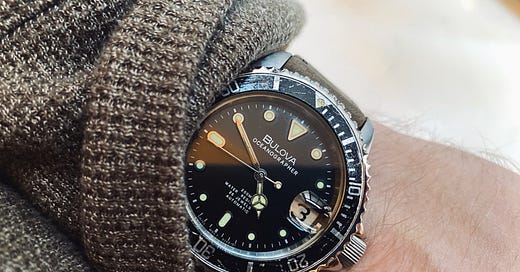



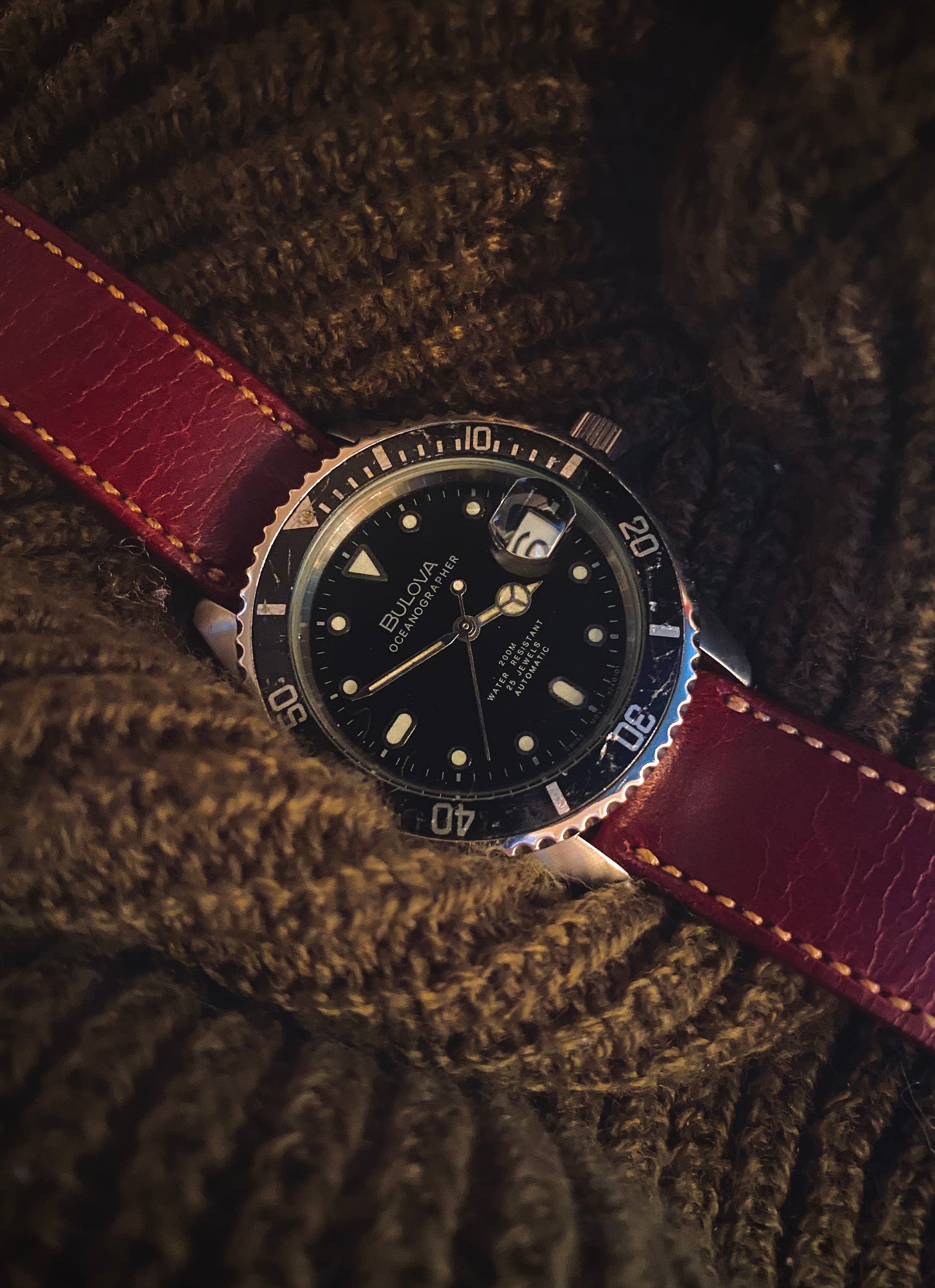
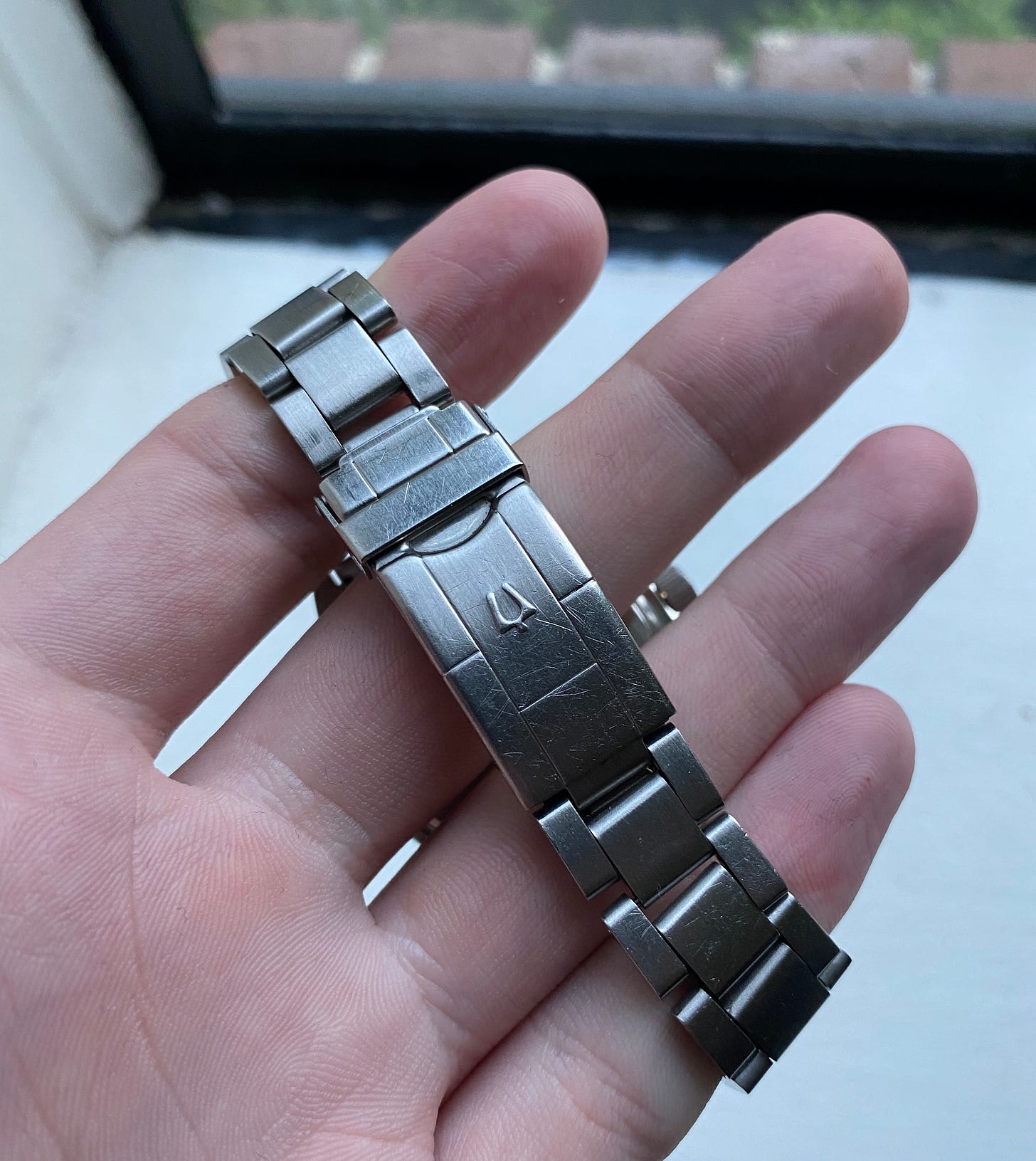
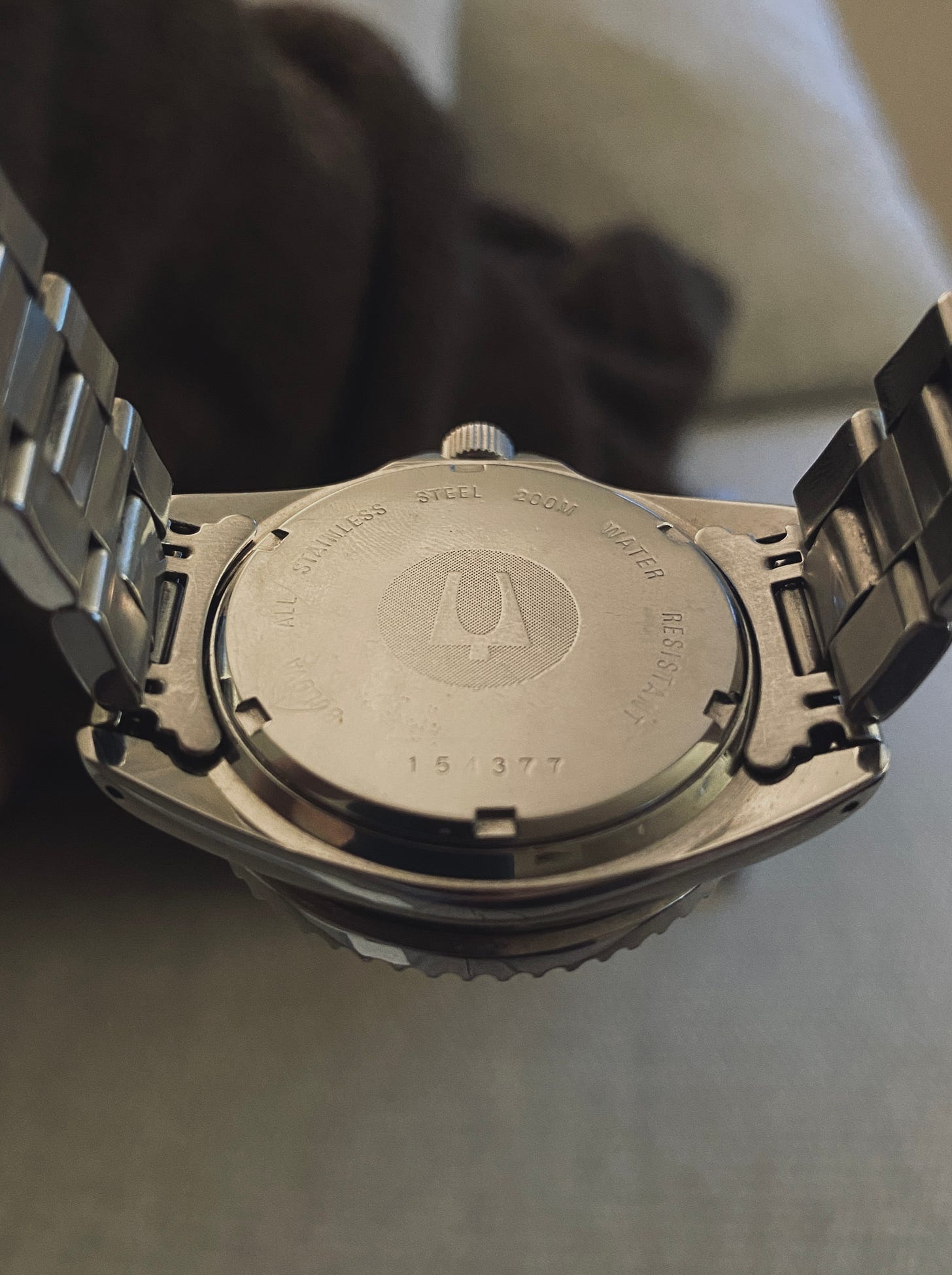
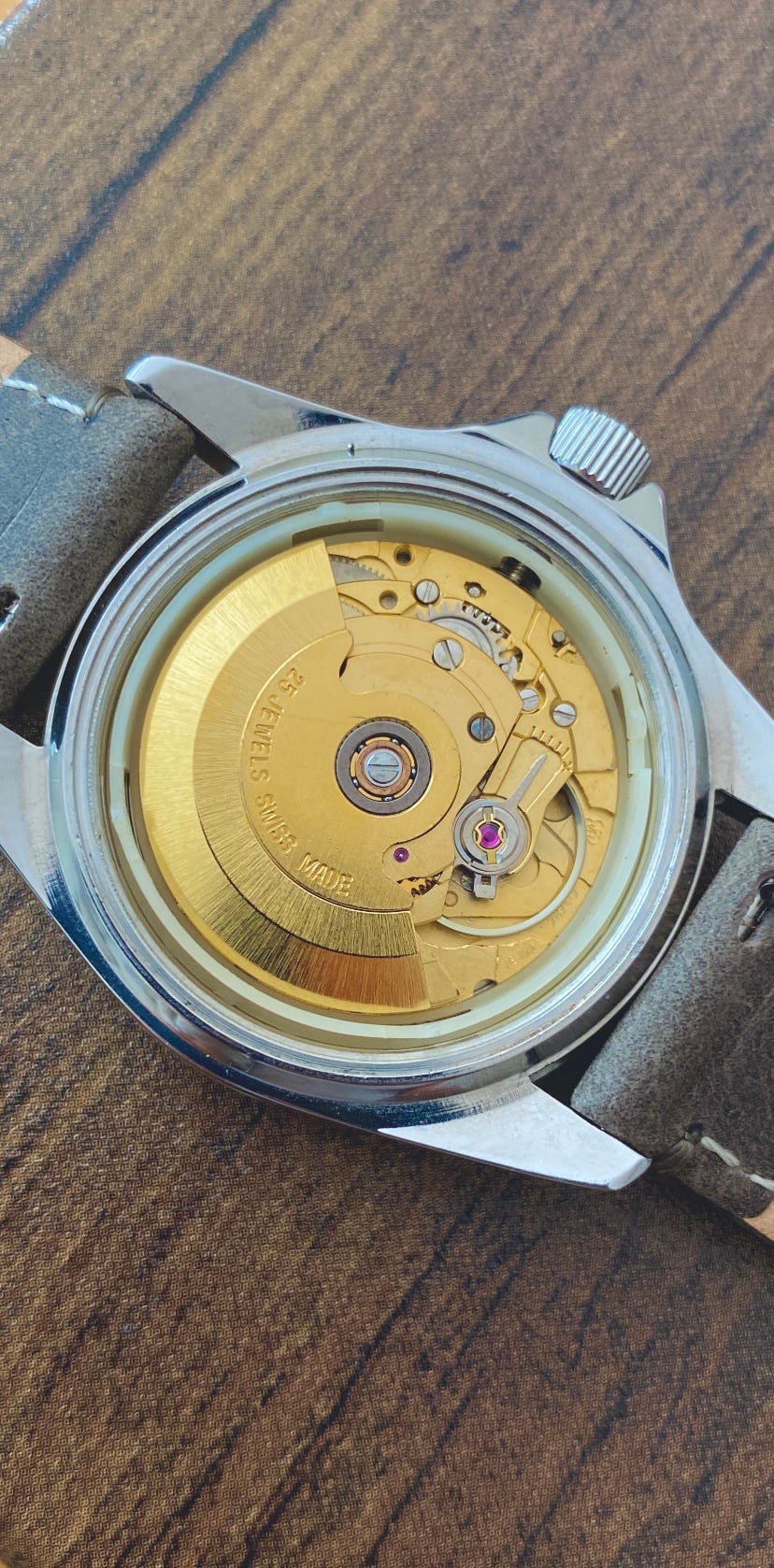
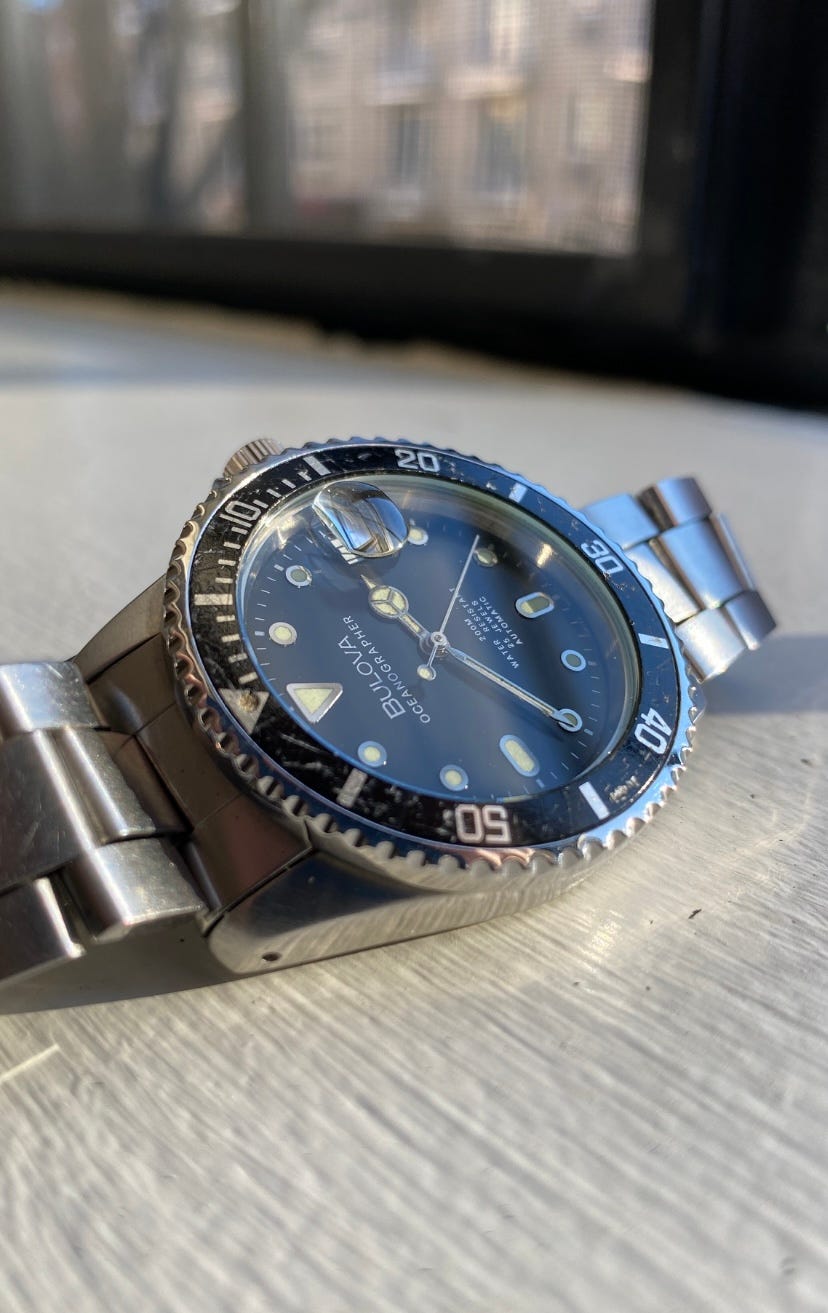
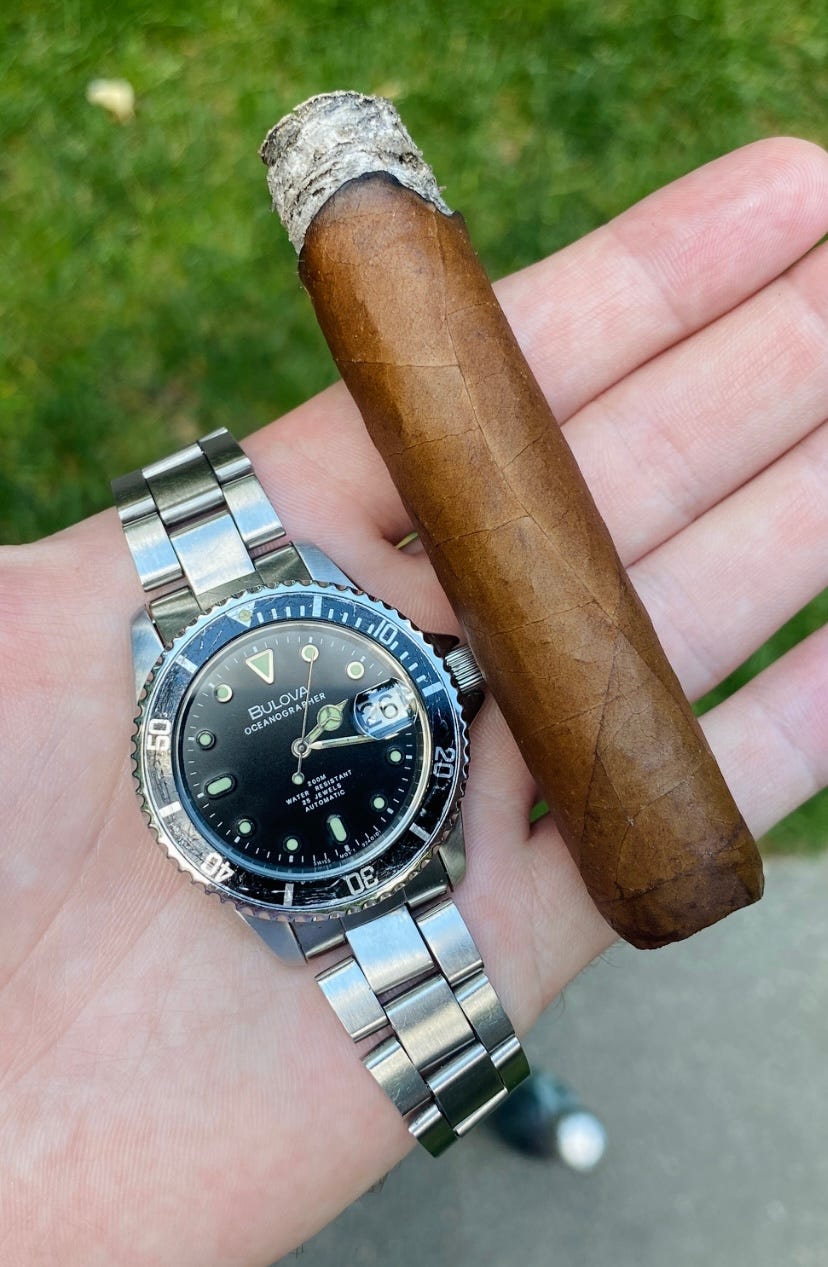
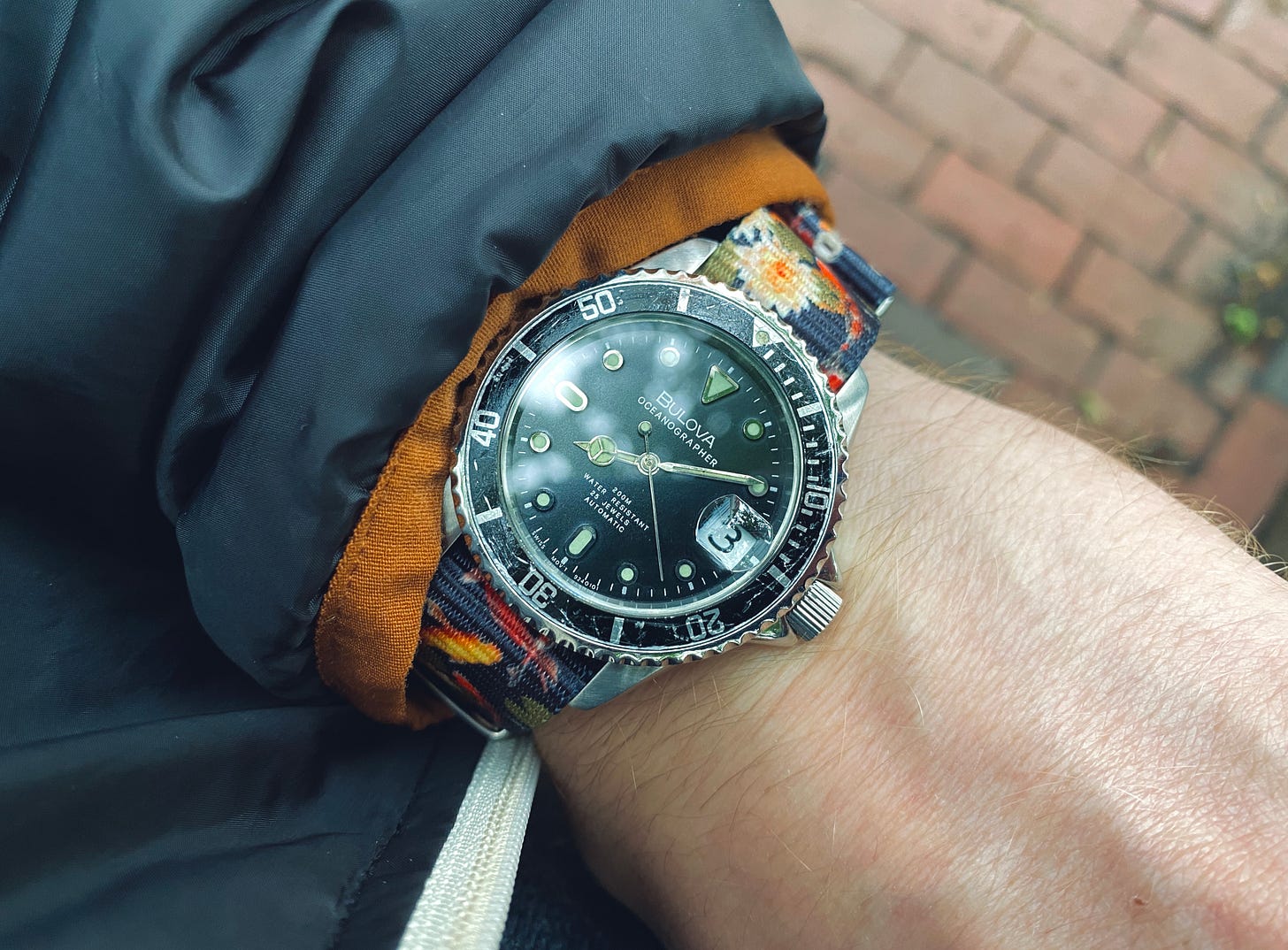
I have chased down both watches AND owners of watches and it one of the most rewarding aspects of this hobby! Well done! And Super Oceanographer!
Hi Mike,
Really enjoyed this article as I love Bulova and would love to own this piece, it’s on my list 😀
What a movement 👌👌👌